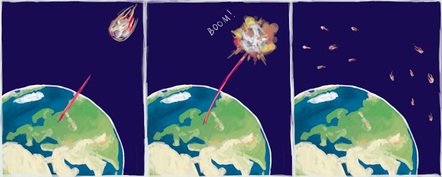This article is more than 1 year old
Russian boffins blow up teeny asteroids with tiny laser... to work out how to nuke the real thing
We're told Bruce Willis is standing by
The next time a giant asteroid threatens the Earth, Russia may just know how many megatons of explosives are needed to blow the thing to smithereens.
Boffins from the Rosatom State Nuclear Energy Corporation and the Moscow Institute of Physics and Technology (MIPT) have been busy modelling the impact of a nuclear explosion on an Armageddon-sized asteroid by building miniature models of the space rocks and blasting them with laser beams.
Russia has history when it comes to asteroids: on 15 February 2013 a meteor exploded at 97,000ft over Chelyabinsk Oblast, in the Ural Mountains region, with a force of 26 to 33 times the energy released by the Hiroshima atomic bomb.
Minds have since been focused by the potential damage a much larger asteroid could cause.
There are two courses of action when faced with a civilisation-ending rock hurtling towards the earth at 20km per second – either deflect it or blow it into tiny pieces that will burn up harmlessly in the atmosphere.

"Artist's impression" of asteroid destruction. [Author: Elena Khavina, MIPT Press Office]
Researchers sampled the chondrite fragments of the Chelyabinsk meteor and manufactured miniature imitations, taking care to match the composition of the original and creating various shapes to better understand the dynamics of the destruction.
The models were then blasted by a laser in a vacuum chamber for 0.5-30 nanoseconds while boffins looked on.
The team was then able to extrapolate from the results, and knowledge of the Chelyabinsk meteor, that if, for example, a 500 joule laser pulse could destroy a 8-10 mm model, then it would take the energy of three megatons of TNT to shatter a 200-metre asteroid.
To put that in context, the Tsar Bomba (King of Bombs) produced a yield of 50 megatons when detonated in 1961.
The researchers also discovered that multiple, weaker laser pulses had no significant advantage over one big one, and that less energy was required if the laser energy was targeted at a cavity within the asteroid, meaning that the sacrifices of Bruce Willis's drilling team would not have been in vain.
The team plans to continue blowing things up their research and experiment with different asteroid compositions and shapes to better understand the destruction criteria. ®
